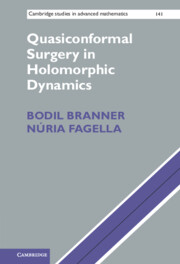Book contents
- Frontmatter
- Dedication
- Contents
- List of contributors
- Preface
- Acknowledgements
- List of symbols
- Introduction
- 1 Quasiconformal geometry
- 2 Boundary behaviour of quasiconformal maps: extensions and interpolations
- 3 Preliminaries on dynamical systems and actions of Kleinian groups
- 4 Introduction to surgery and first occurrences
- 5 General principles of surgery
- 6 Soft surgeries
- 7 Cut and paste surgeries
- 8 Cut and paste surgeries with sectors
- 9 Trans-quasiconformal surgery
- References
- Index
4 - Introduction to surgery and first occurrences
Published online by Cambridge University Press: 05 February 2014
- Frontmatter
- Dedication
- Contents
- List of contributors
- Preface
- Acknowledgements
- List of symbols
- Introduction
- 1 Quasiconformal geometry
- 2 Boundary behaviour of quasiconformal maps: extensions and interpolations
- 3 Preliminaries on dynamical systems and actions of Kleinian groups
- 4 Introduction to surgery and first occurrences
- 5 General principles of surgery
- 6 Soft surgeries
- 7 Cut and paste surgeries
- 8 Cut and paste surgeries with sectors
- 9 Trans-quasiconformal surgery
- References
- Index
Summary
In this chapter we describe what quasiconformal surgery is about and explain the surgeries which were developed as the first occurrences of this technique: the parametrization of hyperbolic components of the Mandelbrot set and the proof of the No Wandering Domains Theorem.
Generalities What is known as quasiconformal surgery in holomorphic dynamics is a technique commonly used to construct holomorphic maps with prescribed dynamics. The ‘prescribed dynamics’ are given by a map f which in general is not holomorphic, although it may be. We shall refer to f as the model map. The word surgery appears because one may need to ‘cut’ and ‘paste’ different spaces and maps together to construct f. This is usually the first step in the construction and is known as topological surgery.
We are leaving the holomorphic world in order to have a greater choice for our models, and then checking whether the model map has a ‘holomorphic dynamical copy’, i.e. whether there exists a holomorphic map conjugate to f. The main tool for obtaining ‘holomorphic dynamical copies’ is to apply the Integrability Theorem (Theorem 1.28), which provides a quasiconformal conjugacy to return to the holomorphic setting (see the Key Lemma (Lemma 1.39)). It follows that we should look for models in the space of quasiregular maps (see Proposition 1.37).
- Type
- Chapter
- Information
- Quasiconformal Surgery in Holomorphic Dynamics , pp. 147 - 178Publisher: Cambridge University PressPrint publication year: 2014



